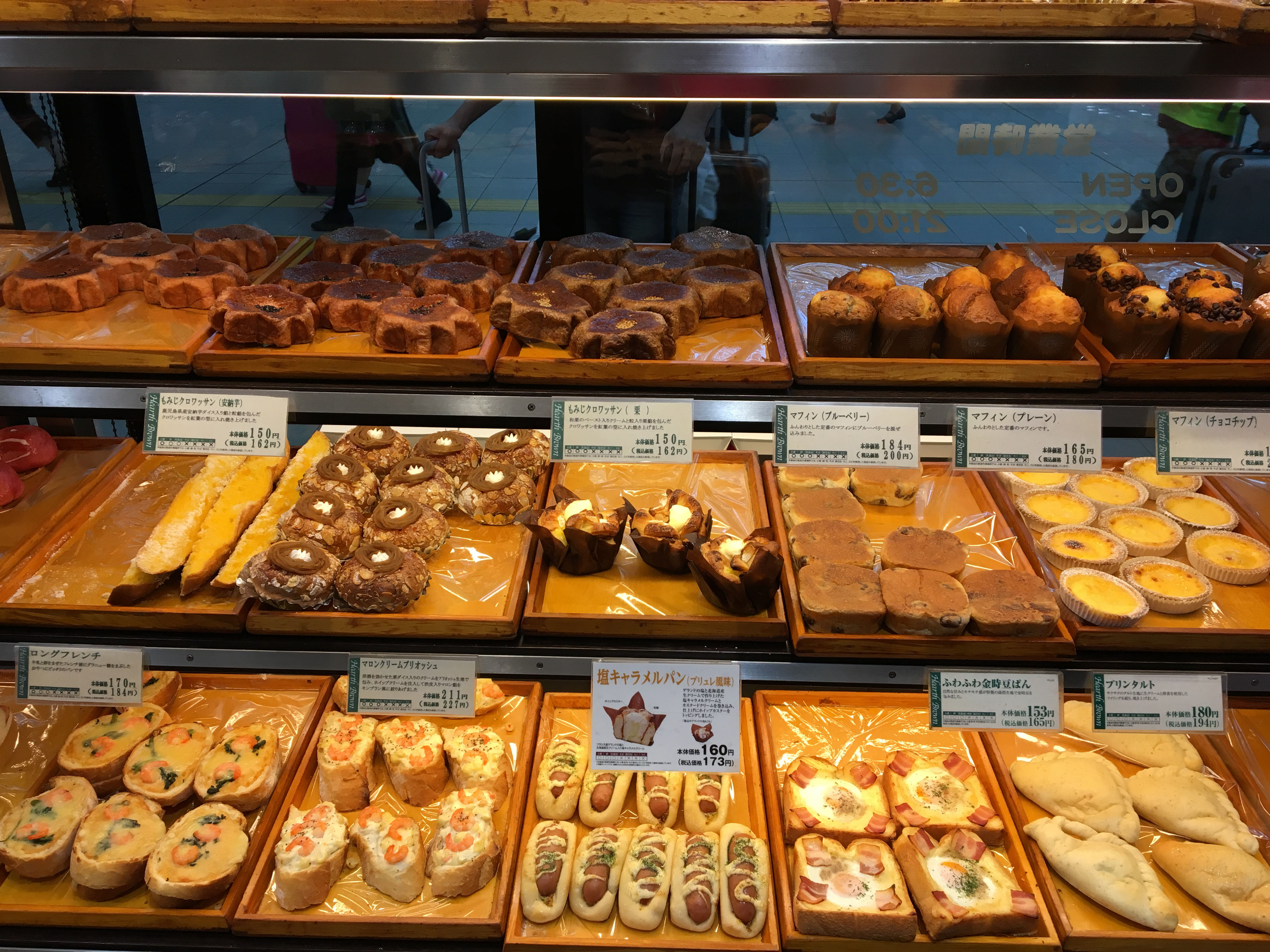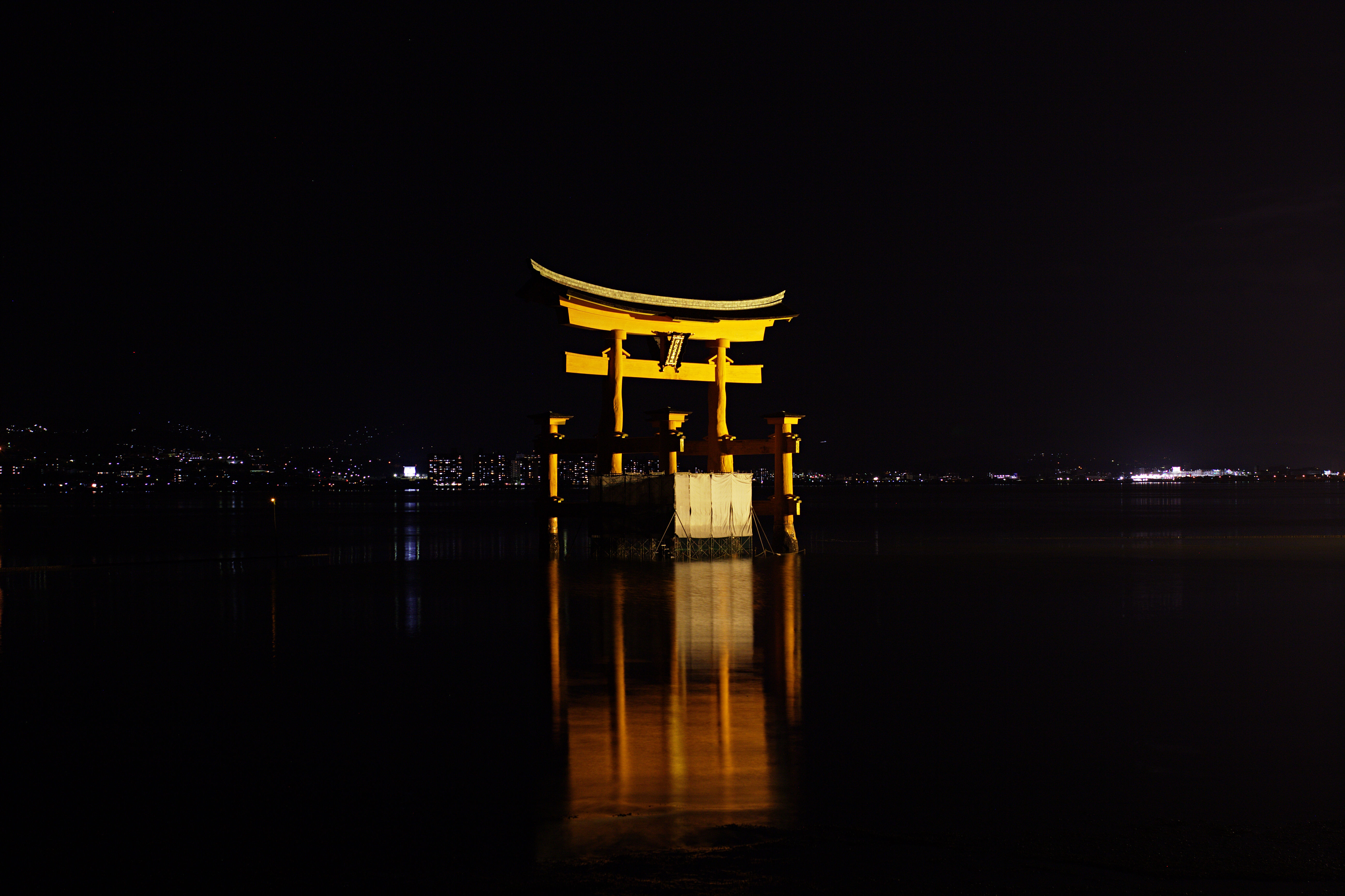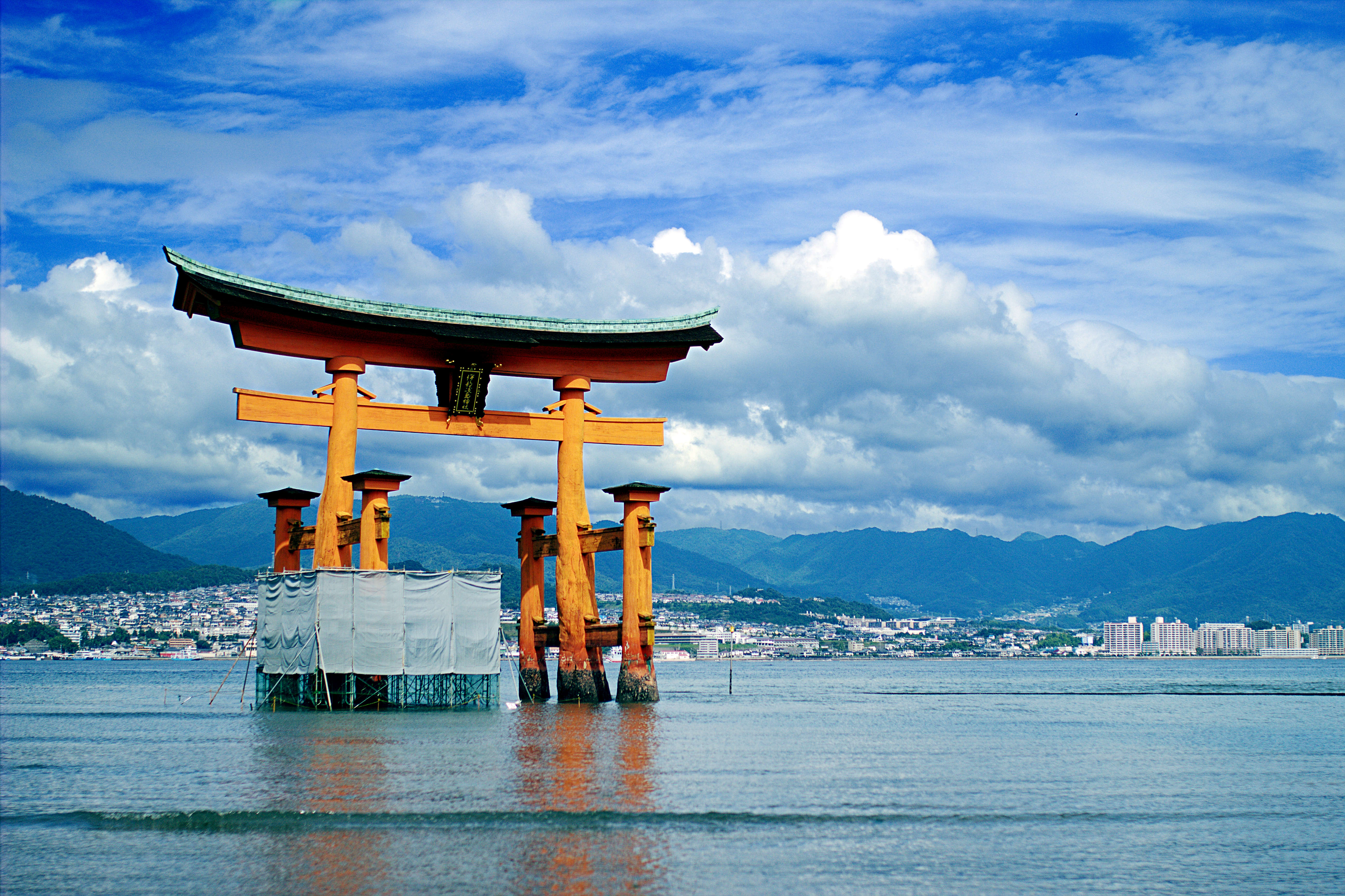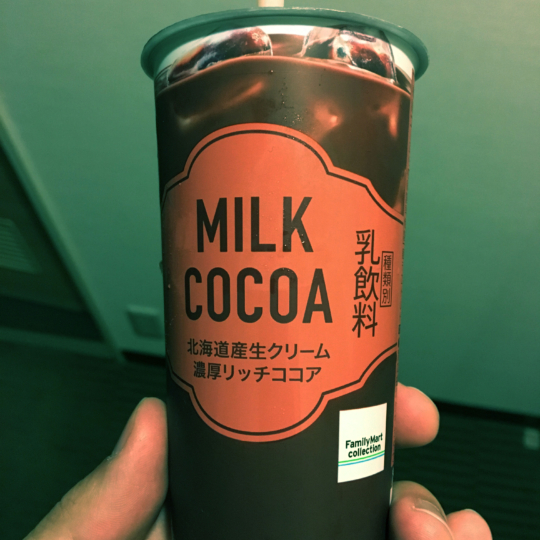Today we checked out of our hotel in Shinjuku around 9:00 am. We donned our water shoes and headed to the station, about a 12 minute walk. It was pouring down rain too, so we were once again soaked quickly. We had to wear our backpacks on our fronts to keep them covered under our ¥400 ($4) umbrellas we bought our second day in Japan. They have served us well and we carry them still. I also had my camera bag stacked on top of my backpack so ooo the walk to the station was irritable. We caught a quick train over to Tokyo Station to board the shinkansen.

This video doesn’t do the shinkansen justice on its speed, but maybe you can grasp how fast the scenery is flying by as we sped out of Tokyo and into the country side.
A few hours later we had to change to another shinkansen in Shin-Osaka station. Where had about an hour to kill and we found this little bakery inside. Look at some of these desserts:

Once it was time to leave again, we boarded our shinkansen and were underwear again. Here’s the scenery near Shin-Osaka Station.
Once in Miyajimaguchi, we left the station and followed the signs to for the ferry to Miyajima Island. The signs led us along a road through a small downtown area then under the road and back up the other side. So far here, the weather was gloomy looking, but never rained on us. We wound our way down the dock and onto the ferry, which would take us over to the island for our night in a ryokan. The ferry ride was about 15 minutes long and provided a beautiful view of the bay around us.
As we crossed over the bay we felt really relaxed after having a hectic day catching various trains to reach the island. Miyajima Island was nothing but laid-back and breathtakingly beautiful. Once we docked on the island we walked through the ferry station and out onto the main street. Here we were greeted by a wild deer that are quite numerous on the island. We saw them all over the place, on the streets, in park areas, in the woods, in alley ways and pretty much anywhere else you can think of. It walked over to us and I was holding our itinerary with our ryokan’s address on it when I noticed it was slowly being sucked into the deer’s mouth! Fortunately, it only got wet and not ripped. Later that night we would see more deer about and we laughed to ourselves thinking how much this island seemed straight from a fairy tale with its picturesque landscapes and friendly deer.

After petting the deer and getting our pictures with it, we looked for a cab. I showed the driver our address and he said, “hai!” (yes) and we were off. Now see, the roads on this island are one laners and super tight, sometimes the turns were ridiculously sharp yet our driver never slowed down. We came around a turn and there was another car headed right for us. I thought surely one will have to back up, but nope. They managed to squeeze past each other. When people were in the road I swear our driver sped up toward them to get them to move; it was great. After about 5 minutes we reached the ryokan and were dropped off at the base of a stone stairway leading up to it.

We entered and rang the bell for assistance. An elderly man came out and took our passports to check us in. He then asked when we wanted dinner and breakfast and weather western or japanese style. We did a 7:00 pm dinner and an 8:00 am breakfast, both japanese style. He then asked if we wanted a private bath or not and if we wanted private we’d have to reserve the time. Now I knew ryokan were traditional japanese hotels from ye olden days, so I figured it’s a common bathroom but if we have the option to have it private then that’s what we want. I said private reserved time sounds good and he goes, “ok, then from 6:00 to 6:30 pm.” It was 5:45 pm when we checked in and I was thinking, it’s a bit early to shower up for the night plus I wanted a morning shower. Whatever… We then were asked to follow a lady who would take us to our room. She spoke very broken english, but we understood everything she was trying to tell us. She explained everything about the ryokan to us.
As you enter your room you enter on one level that is really one step down from the rest of the room. Here is where you leave your shoes. You then walk through a sliding door and the room inside is floored with tatami mats. The room smelled of straw, as tatami is rice straw. In the center of the room was a short table with chairs that had backs but no legs on them. They were very comfortable, at least for me as I like sitting close to or on the ground as it is. She explained the yukata (japanses robes to us) and turned the AC on. She then excused her self and when leaving she opened the sliding door on her way our and knelt down in so doing, just like you see in old japanese movies. At a ryokan you are truly well taken care of. We checked out the room a bit and wondered where our beds were. No idea… We then deliberated on wearing the yukata as we weren’t sure where to wear them whether only in the room or to dinner as well. We got on Google for this one. Google says wear the yukata everywhere. So we put them on. We were wondering would we be the only ones at dinner with them on or not. I felt it’d be a lose-lose, we wear them no one else does, we don’t wear them and everyone else does. We donned the robes and took pictures. Sara went with the traditional japanese lady pose and I went with a samurai pose, specifically Miyamoto Musashi the sweetest most bad-ass samurai ever. Seriously go google him right now. Here are our yukata pictures:


We went down to dinner and in the elevator another couple, probably in their 40s rode along, no yukata. Sara and I looked at each other and shrugged, silently motioning, “yup…” We then reached the restaurant where our hostess led the couple first to their seats with all the other guests… yukata-less. Great we are the gaijin of gaijin (gaijin = foreigner(s)). We were then led to another room, why you may ask? Because there was one other couple in yukata there. They immediately said, “oh thank God, we thought we were gonna be the only ones.” We quickly replied the same. They ended up being from Oregon. A few minutes later another couple, this time japanese showed up in their yukata as well.
We were then served our meal which was very good. Somethings were strange and we had no idea how to eat them, but we were given some help to get through the meal. I didn’t get any pictures as it was sort of formal and I didn’t think it was the right time to do that.
After dinner we walked quickly down to the beach to get a night picture of the O-Torii at Itsukushima Shrine (said eet-skush-eema). Here you can see some renovation is being done on it to persevere it. Nevertheless it was a brilliant piece of architecture.

We then went to bed. In the morning we got up, had another traditional japanese meal which was also very good. We then packed our bags and checked out. Today, we had to carry our backpacks and the camera bag on our backs all day on the island as well as at Hiroshima and to Kyoto. At first the weight wasn’t too bad, but after some time it was tiring, but more so in just pulling oddly on our shoulders as we had school backpacks and not actually hunting bags or something along those lines.
Anyways, we started up the mountains to the buddhist Daisho-in Temple. We saw many statues and ornaments all around. The scenery and atmosphere was very tranquil especially with a cooler morning breeze finding its way amongst the trees.


Once we checked the temple out we started down the mountain to take some pictures with the torii during the day too. On the way down, we saw a giant bell to ring so here it is. The reverb on this thing was immense and you could hear it ring out for several minutes before fading away completely.
We made it back down to the torii and the tide was out so we could walk closer to it.

Once we got our torii pictures, we sat a few minutes to take our packs off and give our shoulders a break. We then got some traditional japanese ice cream in a sandwich made of the ice cream cone material.

We made our way back to the ferry to get back to Miyajimaguchi to catch our train up to Hiroshima. On the way back we stopped at our first legitimate tourist trap, although it was free. The world’s largest rice scoop!

Done with the scoop we left for the dock for the ferry and we were intercepted by more deer. We came across this one eating some paper and as I took this picture the lady was ripping it back out of its mouth:

We loaded back onto the ferry and then boarded our local line back to Hiroshima, about a 30 minute ride. When we reached Hiroshima, we exited the station and looked for the tram to Genbaku Dome-mae (the Atomic Bomb Dome). To the ride the tram you get on, but have to pay to get off. Well once we got on we saw each door had an electronic card reader for which we didn’t have the card. We looked where to drop our coins, but to no avail. We were looking for some help, but no one knew english around us so we needed to do a quick google search for the word, “to pay” in japanese before our stop came and it was coming quickly. We found the word and I was able to ask a lady across from us, “suimasen, doko ni shaharaimasu ka?” (“excuse me, where do I pay?”) now whether that’s 100% right or not didn’t matter as she understood and told us the coin slot was by the driver. Arigatou gozaimasu!!!
We got to our stop, paid and had a few second walk to the dome. In case you didn’t know the Atomic Bomb Dome is the one of the few buildings that remained standing after the atom bomb fell on Hiroshima August 6, 1945, however it was the only building left standing directly under the hypocenter of the explosion 1968 ft (600 m) above the ground. When the bomb went off an estimated 70 000 people were killed instantly.
Looking at the structure and in the air above it trying to picture where the bomb detonated, it was tough to imagine where so much life was happening around us at the moment from the people talking, the sounds of the busy streets and birds singing and green trees all around that 71 years ago so many lives were ended and an entire city vaporized.
We circled around the dome taking pictures from every angle and reading some signs about it on the way. One that stuck out to me was a simple sign that stated the dates of restoration and the final line of it said, “these ruins will be preserved forever.” I found that rather interesting as being american I wasn’t sure what the japanese would think of the bombing today, but after being there I see now they view the dome as a memorial to peace and the prevention of nuclear bombings in the future. As we walked along the path around it too we saw what looked like a bench when a japanese gentleman, middle-aged, saw me with my camera and explained that, what we thought was a bench (not that we were sitting on it though) was actually a piece of a pillar blown away from the main dome structure and he recommended getting pictures of it. I did.


Interestingly, we saw a lot of japanese people taking selfies and smiling pictures in front of the dome. We, on the other hand, felt we shouldn’t do this at all, it didn’t seem like that was really appropriate seeing what Hiroshima is and what its history holds. As we walked to the far side of the dome we were met by a TV crew. They told us they were looking for americans to interview about Hiroshima. I told them we were american and they asked if it’d be cool if they interviewed us. I said of course, as the main reason I wanted to visit Hiroshima was to learn how the japanese viewed it and it turns out apparently some wanted to know how we viewed it.
The interviewer started with that very question and I told him I wanted to see Hiroshima to learn how the japanese people viewed it as I’m sure americans and japanese have different perspectives on it. He then asked me what perspectives do americans have about it. I replied that americans view it as a terribly sad event, but at the time a necessary choice to end the war. Now whether it was absolutely the right path to take is debatable, but it was a means to an end and at a very high cost and a decision I’m sure was not made easily.
He then asked what I thought of it. I told him I think it’s fascinating that it’s been kept intact all these years let alone withstanding the explosion to which he completely agreed. I did tell him I found it odd that the japanese like taking their pictures with it and that we would not be doing that. After I explained why, he replied the japanese view it as a sign of peace and peace in the future, so I think that helped bring that into perspective a little bit.
He then asked about President Obama visiting their recently and what my thoughts were on that. I told him in the States the media was making a big deal about it as the government did not want it to look like the US was apologizing for the bombing. He then asked me what I thought. I said I do not think it was seen as an apology, but as a sign of good will between our two countries and I thought that that was quite apparent without President Obama visiting because of our relations with Japan. I told him that I found it very interesting that after such an event that the japanese do not hate americans for it and that they are still welcoming of us and that we are very grateful as visitors to have that opportunity. He loved hearing that, but it was true.

He then thanked us for our time and we thanked him and went on our way. We headed over to the Peace Memorial Museum. The museum held artifacts from the bombing and it really brought the lives affected by the bombing into light. I mean to say that, growing up in the States, or really anywhere else in the world, yes we learn about the bomb, we’ve seen the videos but you don’t really think about what it actually did to the people on the ground. We saw clothes that were torn and tattered and burned. Each item had a description or a story, if it was known, about the person whose belongings they were showing. All of them eventually succumbed to their injuries. A few items that stuck out were one of a school kid’s, tin lunch box where the food was charred black and still inside it. Or the shadow of a person burnt into the concrete steps where they were sitting waiting for the bank to open that day. Another one showed thick, iron window shutters bent inward from the blast some four or so kilometers from the hypocenter. Each item there had the distance it was recovered from the hypocenter. The closest object I saw was 1968 ft (600 m) from the hypocenter.
We spent a few hours in Hiroshima before getting back on the tram to Hiroshima Station and taking another shinkansen to Kyoto. We arrived in Kyoto around 6:30 pm, checked in and went to dinner at a place called Kimukatsu. Here’s what I had to eat:

Pork tonkatsu and fried shrimp, it was very delicious. We then headed back to the hotel room to recover from today’s extensive walking. Tomorrow we tour Kyoto.
Return to top



I don’t know what to say guys! You are doing and seeing everything in this trip I don’t know what will be left when we go back with you! I can’t even comment on any one particular event because they’re all amazing, funny, interesting and crazy. Can’t wait to sit down in November and relive the entire trip with you. Keep the blog going. Can’t wait to hear more.
( glad you got new shoes )
Love you both!
We have seen sooo much while we’ve been here. Seriously we cannot fit it all in. We are adjusting our schedule on the fly as we go from stop to stop. We could use a few extra days here, so when we come back we are definitely doing a full two weeks. You could easily spend the entire time in Tokyo, but then you’d be missing out on the rest of the country. We are looking forward to giving you the ins-and-outs in November as well. Plus I have millions more pictures I haven’t put online yet.